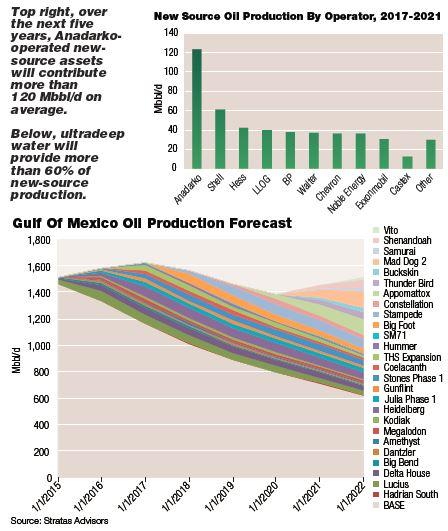 Even with only a handful of projects coming online in 2017, U.S. Gulf of Mexico (GoM) oil production is expected to top 1,600 barrels per day (bbl/d) as several major projects starting on or before 2016 ramp up their production. However, as base production continues to decline, new-source projects start to lose steam. We will see GoM oil production decline in 2018 and reach the bottom in 2020 at about 1.385 million barrels per day (MMbbl/d), a 240,000 bbl/d-drop compared to the high production level of 2017.
Even with only a handful of projects coming online in 2017, U.S. Gulf of Mexico (GoM) oil production is expected to top 1,600 barrels per day (bbl/d) as several major projects starting on or before 2016 ramp up their production. However, as base production continues to decline, new-source projects start to lose steam. We will see GoM oil production decline in 2018 and reach the bottom in 2020 at about 1.385 million barrels per day (MMbbl/d), a 240,000 bbl/d-drop compared to the high production level of 2017.
Project Drought
With operators in GoM cutting investment in the last couple of years, new projects were pushed off their schedules. Only a few small projects are scheduled to come onstream this year, including BP Plc’s Thunder Horse South Expansion project, the Castex Energy Inc.-operated Hummer project in shallow water and the Byron Energy Ltd.-operated SM71 project. The total oil production capacity of these three projects only adds up to 60,000 bbl/d, much less than the 250,000 bbl/d from the projects brought online in 2016.

Looking forward, the drought will continue beyond 2017. Only four major new-source projects are expected to start production in the three years from 2018 to the end of the decade. Hess Corp.’s Stampede project, which was sanctioned in 2014 and is now under construction, is scheduled to start production in 2018; Chevron Corp.’s Big Foot project’s start date has been postponed from 2015 to 2018 due to a tendons failure during the platform installation; the Constellation project (formerly Hopkins) is expected to be a subsea tie-back development after Anadarko Petroleum Corp. took over the operatorship of the field from BP.
Anadarko plans to sanction the project this year and bring it onstream by 2019. Shell Oil Co.’s Appomattox project was sanctioned in 2015 and is in the construction stage with an expected production startup by 2020.
No recovery until 2021
As oil price slowly recovers to above $50/ bbl or higher in the next couple years, deepwater projects in the GoM will become more attractive economically, and more projects are expected to move forward with investment. However, the process will be slow because of the long investment cycle of offshore field developments, and the production gap caused by the project drought will not be filled before the end of the decade. There are several projects in the pipeline to contribute the recovery after 2020, including BP’s recently sanctioned Mad Dog 2 project that is expected to start in 2021. Other potentials include Murphy Exploration & Production Co.’s Samurai project and Thunder Bird (currently stalled), Repsol’s Buckskin project, Andarko’s Shenandoah project and Shell’s Vito Project. The combined production capacity of these projects could reach up to 400,000 bbl/d.
Ultradeep water dominance
The majority, or more than 60%, of new-source production will come from ultradeep water (over 5,000 feet in water depth). Deepwater (water depth greater than 1,000 feet but less than 5,000 feet) accounts for one-third, and shallow water (water depth less than 1,000 feet) only accounts for 5%.
Anadarko leads new-source assets
Anadarko-operated new-source assets will contribute more than 120,000 bbl/d on average in the next five years (2017–2021), followed by Shell, which only has half of Anadarko’s production. Other main players in GoM such as Hess, BP, Chevron and LLOG Exploration Co. are mostly below the 40,000 bbl/d range.
Recommended Reading
Fugro’s Remote Capabilities Usher In New Age of Efficiency, Safety
2024-11-19 - Fugro’s remote operations center allows operators to accomplish the same tasks they’ve done on vessels while being on land.
2024 E&P Meritorious Engineering Awards for Innovation
2024-11-12 - Hart Energy’s MEA program highlights new products and technologies demonstrating innovations in concept, design and application.
Small Steps: The Continuous Journey of Drilling Automation
2024-12-26 - Incremental improvements in drilling technology lead to significant advancements.
Halliburton Sees Strong Adoption of New Oilfield Tech Offerings
2025-01-22 - Halliburton Co.’s Zeus e-fracs, Octiv auto-fracs and the Sensori monitoring platform are setting the stage for long-term growth, CEO Jeff Miller says.
Push-Button Fracs: AI Shaping Well Design, Longer Laterals
2024-11-26 - From horseshoe wells to longer laterals, NexTier, Halliburton and ChampionX are using artificial intelligence to automate drilling and optimize completions.
Comments
Add new comment
This conversation is moderated according to Hart Energy community rules. Please read the rules before joining the discussion. If you’re experiencing any technical problems, please contact our customer care team.





